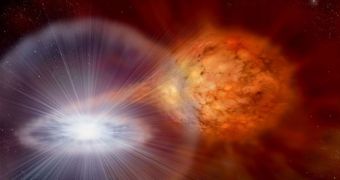According to a new scientific study, it could be that many nova explosions are slipping under astronomers' radar, depriving them of the chance to study events that could lead to a better understanding of this intricate phenomenon.
In the research, the authors suggest that even novae that are very bright may be escaping detection due to a variety of reasons. The new conclusions are based on data collected from Sun-monitoring satellites around Earth.
One such spacecraft was able to discover four nova events. But, while the events were indeed discovered by numerous astronomy crews, two of the four were only discovered when they reached peak emission intensity, and not when they first occurred.
The main point of studying these events is to study them in detail, covering everything starting with the moment they explode until they wane out of the night sky.
If a nova is observed only from the time when it reaches peak brightness onwards, then researchers cannot establish a large number of facts regarding the object that exploded to create the event.
Nova explosions occur mostly on white dwarf stars in binary systems. These objects are usually accompanied by a larger star, from which they continuously accrete mass.
The process goes on around the clock, until the white dwarf gets so heavy that it becomes unstable. When a certain threshold is reached, the star blows up, shedding the extra mass in its surroundings.
However, unlike in a supernova, the explosion does not affect the atmosphere and core of the white dwarf itself. The star continues to live. If it starts the accretion process all over again, then such an object is called a relapsing nova.
When a star goes supernova, it sheds its outer atmosphere in a violent explosion, and then suffers a core implosion that usually leads to the formation of either a neutron star or a black hole.
But the point of the study is that novae, even if not as bright as supernovae, can be easily detected, and yet they are not. Or at least, not all the time, Space reports.
“So far, this research has shown that some novae become so bright that they could have been easily detected with the naked eye by anyone looking in the right direction at the right time, but are being missed, even in our age of sophisticated professional observatories,” says Rebekah Hounsell.
She is the lead author of the new study, and also a graduate student at the Liverpool John Moores University (LJMU), in the United Kingdom.
“The [new] data have in fact opened a new chapter in our observations and understanding of novae," Hounsell goes on to say.

 14 DAY TRIAL //
14 DAY TRIAL //